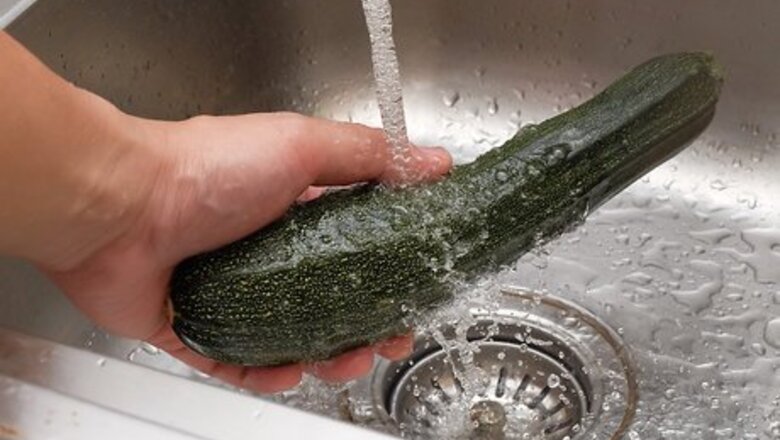
views
Chopping
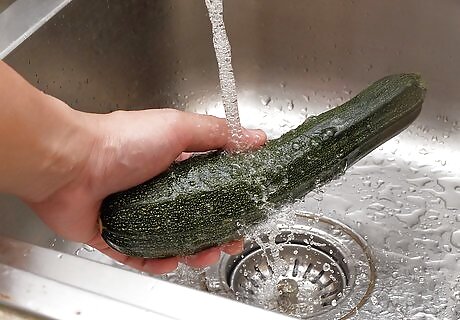
Rinse the zucchini to remove any dirt. Before beginning to slice your zucchini, simply run it under cool water. Brush it gently with your hands to remove any excess dirt.

Chop off the stem and blossom ends with a sharp knife. Cut about ⁄2 inch (1.3 cm) from each end of the zucchini with a chef’s knife and discard the pieces.

Chop off small cylinders of desired thickness. Starting at either end, hold the other end in one hand and cut downwards with a sharp chef’s knife. Keep your fingertips curled down, rather than flat on the zucchini, to prevent accidents. The thicker the slices, the longer they will take to cook. Thicker pieces might be best for longer-cooking dishes like stews, while you might go thinner if you’re simply sauteeing your zucchini. For a cleaner cut, use a rocking motion with the handle end of the knife, keeping the tip pointing down.
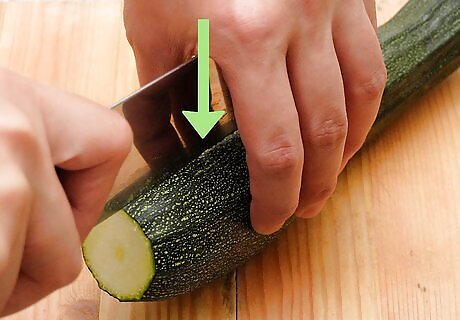
Cut the zucchini in half before slicing for a quicker-cooking dish. To make half-circle slices, cut the zucchini in half lengthwise after you’ve removed the ends. Turn one half horizontally and chop downwards with a knife. Half-slices are great if you want bite-sized chunks, or pieces that will cook faster.
Dicing
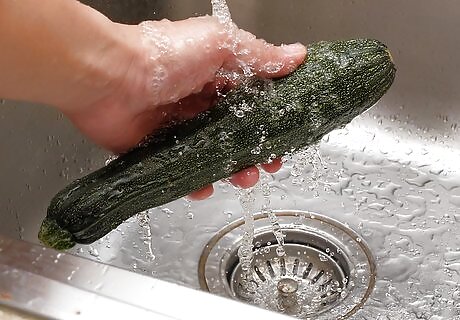
Wash the zucchini before you cut. Rinse your zucchini under cold water to get rid of stray dirt. Dry it lightly with a paper towel and look it over to make sure you didn’t miss any dirt spots.
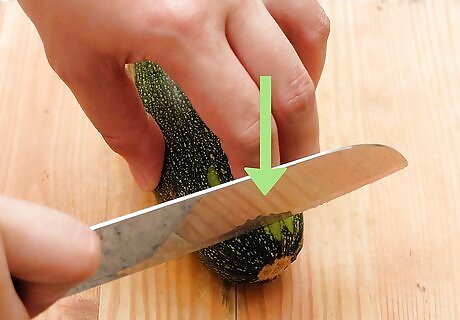
Cut off the stem and blossom ends. Using a chef’s knife, chop off ⁄2 inch (1.3 cm) from each end of the zucchini. The ends don’t taste or look as good, so you’ll cut them off for almost every dish you make.
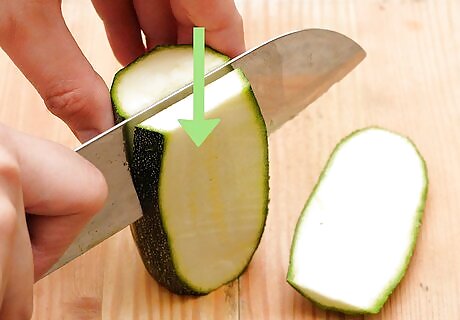
Carefully cut the zucchini into 3-4 vertical strips. Using the same long chef’s knife, cut the zucchini lengthwise into a few strips. Hold it with one hand while you cut, keeping your fingertips curled to protect them from the knife.
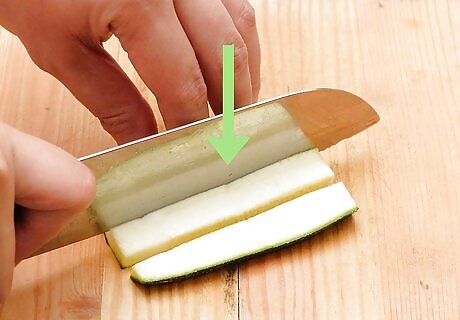
Slice each strip into 3 thinner strips. Place each strip flat on your cutting board. Use the same cutting technique to slice each strip into long, thin slices. When you cut the strips that were on the edge of the zucchini, place the flat side down and the rounded side up for the easiest cut.
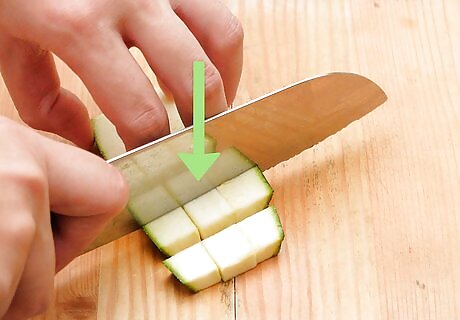
Turn the zucchini and cut crosswise to make cubes. Hold 3-4 thin strips together with one hand, curling your fingertips against the surface. Turn the strips so that you can cut in a crosswise direction, then chop downwards with your knife. Push the small diced pieces to the side with the flat of your blade and continue until you’ve chopped the whole zucchini. Depending on how long your knife is, you might be able to cut through 4-6 strips at once. The more zucchini strips you can chop at once, the less time it’ll take.
Julienning
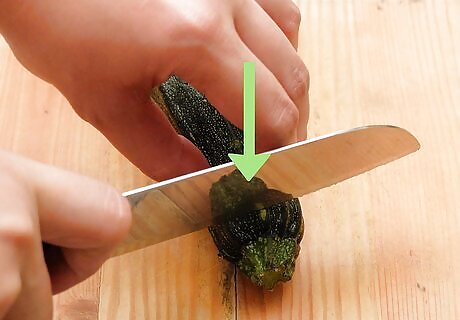
Rinse the zucchini and cut off the ends. Run the zucchini under cool water and pat it dry with a paper towel. Use a chef’s knife to chop off the stem and blossom ends, about ⁄2 inch (1.3 cm) from each tip.
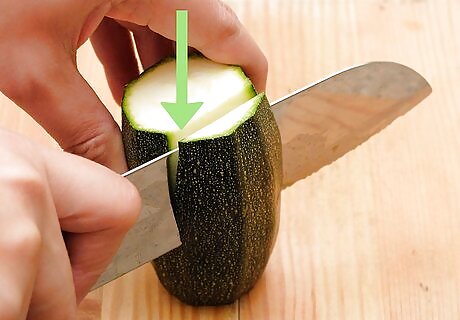
Cut the zucchini lengthwise into ⁄4 inch (0.64 cm) thick planks. Slice down through the zucchini with your knife. Slightly curl the fingertips of your stabilizing hand to keep them away from the blade of the knife. You’ll have 3-4 strips of zucchini once you’re done.
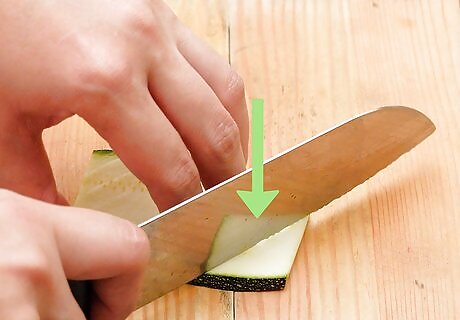
Lay one plank flat and cut the top off at an angle. Turn your knife so that the blade is at about a 45-degree angle to the top left corner of your plank. Chop downwards carefully. You should cut off a triangle-shaped piece of zucchini. You can discard this first small piece--it’s just meant to set up the julienne cuts.
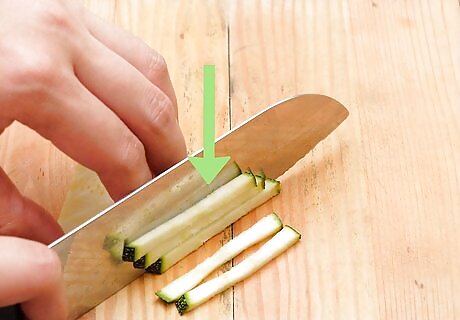
Continue cutting at the same angle, making matchstick-sized pieces. Hold your knife in the same position, keeping the blade parallel to the line of the first cut but about ⁄4 inch (0.64 cm) away. Chop downwards to create thin slices that look a bit like small french fries. Repeat on the rest of the zucchini planks. The Julienne cut is great if you want to add a fancy but simple touch to a salad or side dish.
Grating
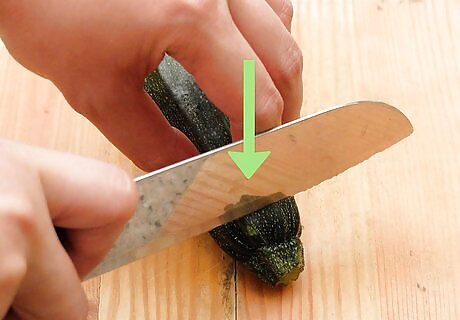
Rinse the zucchini and cut off both ends. Wash off the zucchini under cool water, running your hands over it to brush off any left over dirt. Dry it gently with a paper towel, then place it on a cutting board and slice off both ends with a chef’s knife.

Chop the zucchini in quarters and remove the seeds. Use your chef’s knife to cut the zucchini in half horizontally, then cut both of the halves lengthwise as well. Use a spoon to scoop out the seeds. The seeds and water in the middle of the zucchini won’t grate well, so it’s best to remove them beforehand. This is especially important if your zucchini weighs 1 pound (0.45 kg) or more, as the middle of larger zucchinis tends to be quite bitter.

Grate one quarter at a time against the large holes on a box grater. Hold the box grater with one hand, tilting the side with larger holes slightly upwards for easier access. Place the zucchini firmly against the side and run it up and down the grater until you get to the end. If you have a food processor, you can use the grating blade to slice up your zucchini as well.
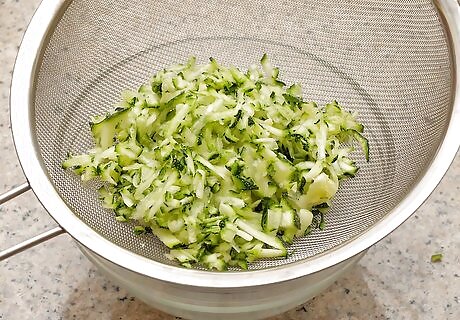
Place the grated zucchini in a colander. As you finish grating each quarter of the zucchini, put the grated shreds into a colander set inside a bowl. The colander, which has holes in the bottom, will allow excess moisture to drain out of your zucchini. If you want to save your zucchini juice, set your colander inside a large bowl. You can use the juice as a quick, healthy addition in soups or for cooking rice.
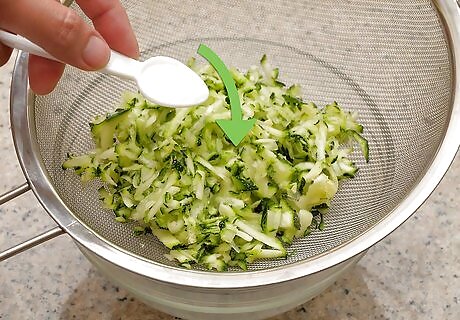
Mix in 1 teaspoon (4.9 mL) of salt and let it sit. Stir the salt around with a spoon to spread it evenly. Let the zucchini drain slowly for 15-20 minutes, then squeeze out any last moisture with your hands. Use 1 teaspoon (4.9 mL) of salt per 1 pound (0.45 kg) of zucchini. Salt will help draw the water out of the zucchini even faster.

Place the grated zucchini onto a paper towel-covered plate. Spread the grated zucchini out evenly so the paper towel can soak up some more of its moisture. Removing the last bits of moisture will help the zucchini from being soggy, while still keeping it fresh for cooking.

















Comments
0 comment